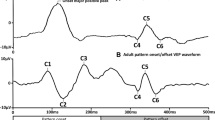Summary
Normal regional blood flow was documented by Single Photon Emission Computed Tomograms 5 and 20 hours before the full recovery of cortical blindness in two patients, lending itself to the possibility of being a prognostic factor. Rubbing of the posterior cerebral arteries against the tentorial edges during trauma instead of traction was believed to cause blindness in one patient and embolization due to hammering bone grafts home during cervical spinal fusion, in the other. Pattern reversal visual evoked responses (PRVERs) were absent during blindness; upon recovery P 100 with full amplitude and normal latency appeared despite the presence of tunnel vision. These are consistent with the fact that the central 8–10 degrees of visual field represented in the posterior occipital poles being the main sources of P 100 in association with the x-cells in the centre of the retina.
Similar content being viewed by others
References
Aldrich MS, Alessi AG, Beck RW, Gilman S (1987) Cortical blindness: etiology, diagnosis and prognosis. Ann Neurol 21: 149–158
Barnet AB, Manson JI, Wilner E (1970) Acute cerebral blindness in childhood: six cases studied clinically and electrophysiologically. Neurology 20: 1147–1156
Bodian M (1964) Transient loss of vision following head injury. NY State J Med 64: 916–920
Bodis-Wollner I (1977) Recovery from cerebral blindness: evoked potential and psychophysical measurements. Electroenceph Clin Neurophysiol 42: 178–184
Bramwell B, Bolton JS, Robinson W (1915) Bilateral lesion of the occipital lobes with retention of macular as distinct from panoramic vision. Brain 38: 447–472
Cedzich C, Schramm J, Wenzel D (1990) Reversible visual loss after shunt malfunction. Acta Neurochir (Wien) 105: 121–123
Celesia GG, Archer CR, Kuroiwa Y, Goldfaber PR (1980) Visual function of extrageniculo-calcarine system in man: relationship to cortical blindness. Arch Neurol 37: 704–706
Duchowny MS, Weiss IP, Majlessi H, Barnet AB (1974) Visual evoked responses in childhood cortical blindness after head trauma and meningitis: a longitudinal study of six cases. Neurology 24: 933–940
Eldrige PR, Punt JAG (1988) Transient traumatic cortical blindness in children. Lancet 1: 815–816
Fischer-Williams M, Gottschalk PG, Browell JN (1970) Transient cortical blindness: an unusual complication of coronary angiography. Neurology 20: 353–355
Gjerris F, Mellemgaard L (1969) Transitory cortical blindness in head injury. Acta Neurol Scand 45: 623–631
Greenblatt SH (1973) Posttraumatic transient cortical blindness: association with migraine and seizure diatheses. JAMA 225: 1073–1078
Griffith JF, Dodge PR (1968) Transient blindness following head injury in children. New Engl J Med 278: 638–651
Haas DC, Sovner RD (1969) Migraine attacks triggered by mild head trauma, and their relation to certain post-traumatic disorders of childhood. J Neurol Neurosurg Psychiatry 32: 548–554
Harden A, Pampiglione G (1970) Neurophysiological approach to disorders of vision. Lancet 1: 805–809
Hess CW, Meienberg O, Ludin HP (1982) Visual evoked potentials in acute occipital blindness: diagnostic and prognostic value. J Neurol 227: 193–200
Hoyt WF, Walsh FB (1958) Cortical blindness with partial recovery following acute cerebral anoxia from cardiac arrest. Arch Ophthal 60: 1061–1069
Kooi KA, Sharbrough III FW (1966) Electrophysiological findings in cortical blindness. Report of a case. Electroenceph Clin Neurophysiol 20: 260–263
Madsen FF (1990) Regional cerebral blood flow after a localized cerebral contusion in pigs. Acta Neurochir (Wien) 105: 150–157
Oka H, Kako M, Matsushima M, Ando K (1977) Traumatic spreading depression syndrome: review of a particular type of head injury in 37 patients. Brain 100: 287–298
Rietveld WJ, Tordoir WE, Duyff JW (1965) Contribution of fovea and parafovea to the visual evoked response. Acta Physiol Pharmacol Neel 13: 330–339
Spalding JMK (1952) Wounds of the visual pathway. Part II: the striate cortex. J Neurol Neurosurg Psychiatry 15: 169–181
Symonds C, Mackenzie I (1957) Bilateral loss of vision from cerebral infarction. Brain 80: 415–455
Author information
Authors and Affiliations
Rights and permissions
About this article
Cite this article
Wong, C.W., Chen, T.Y., Liao, J.J. et al. Serial regional blood flow and visual evoked responses in transient cortical blindness. Acta neurochir 120, 187–189 (1993). https://doi.org/10.1007/BF02112040
Issue Date:
DOI: https://doi.org/10.1007/BF02112040




